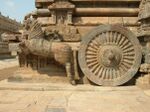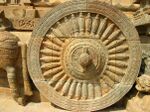Philosophy:Ratha Kalpana
| Part of a series on | |
| Hindu philosophy | |
|---|---|
 | |
| Orthodox | |
|
|
|
| Heterodox | |
|
|
|
Ratha Kalpana (from Script error: The function "iso_639_name" does not exist. ratha 'chariot', and kalpana 'image')[1] is a metaphor used in Hindu scriptures to describe the relationship between the senses, mind, intellect and the Self.[2][3] The metaphor was first used in the Katha Upanishad and is thought to have inspired similar descriptions in the Bhagavad Gita, the Dhammapada and Plato's Phaedrus.[4][5][6][7] Gerald James Larson, a scholar of Indian philosophies, believes that the chariot metaphor contains one of the earliest references to ideas and terminology of the Indian philosophical school Samkhya.[8]
Background
The chariot analogy first appears the third chapter of Katha Upanishad, as a device to explain the Atman (Self) as distinct from the mind, intelligence and sense organs. In this context, spiritual practice is seen as a return to consciousness through the levels of manifested existence.[9] The metaphor forms a part of the teaching imparted to Nachiketa, a child seeking knowledge about life after death, by Yama, the Hindu god of death.
William K. Mahony, in The Artful Universe: An Introduction to the Vedic Religious Imagination, writes, "We have in this metaphor an image of a powerful process that can either lead to fulfillment or in which the seeker can become lost."[10]
Analogy
Verses 1.3.3–11 of Katha Upanishad deal with the allegoric expression of human body as a chariot.[5] The body is equated to a chariot where the horses are the senses, the mind is the reins, and the driver or charioteer is the intellect.[2] The passenger of the chariot is the Self (Atman). Through this analogy, it is explained that the Atman is separate from the physical body, just as the passenger of a chariot is separate from the chariot. The verses conclude by describing control of the chariot and contemplation on the Self as ways by which the intellect acquires Self Knowledge.[11]
He who has the understanding of the driver of the chariot and controls the rein of his mind,
he reaches the end of the journey, that supreme abode of the all–pervading—Katha Upanishad 1.3.10–11[5]
Shankaracharya Commentary:
Here a chariot is imagined for the atman, conditioned in Samsara, entitled to acquire knowledge and perform Karma for attaining emancipation and for traveling in Samsara, as a means to reach both. Know the atman, who is the enjoyer of the fruits of Karma and is in the bondage of Samsara, to be the lord of the chariot. Know the body to be verily the chariot, because like a chariot the body is drawn by the senses occupying the place of horses. Know also the intelligence to be the driver, furnished with the capacity for determination, because the body is mainly guided by the intelligence, as the chariot is mainly guided by the driver; for, everything done by the body is generally done by the intelligence. Know the mind with its characteristics of volition, doubt, etc., to be the reins; for, the senses, such as the ear, perform their functions when grasped by the mind as horses by the reins.
See also
- Chariot Allegory
- Kosha
- Vajira
References
Notes
Citations
- ↑ Monier Williams Sanskrit–English Dictionary.
- ↑ 2.0 2.1 Vedanta Kesari 1967, p. 479.
- ↑ Upadhyaya 1998, p. 114.
- ↑ Izzo 2009, p. 20.
- ↑ 5.0 5.1 5.2 Sivaraman 1989, p. 203.
- ↑ Wynne 2007, pp. 25–26.
- ↑ Jacobsen 2008, p. 381.
- ↑ Larson 1998, pp. 96–98.
- ↑ Whicher 1998, pp. 18–19.
- ↑ Mahony 1998, p. 186.
- ↑ Saraswati 2002, p. 164.
- ↑ The Katha and Prasna Upanishads and Sri Sankaras Commentary. 2. Madras. 1928. p. 54. http://universaltheosophy.com/pdf-library/upanishads/Volume%202%20-%20Katha%20&%20Prasna%20Upanishads.pdf.
Bibliography
- Easwaran, Eknath (2009), Essence of the Upanishads: A Key to Indian Spirituality, Nilgiri Press, ISBN 978-1-58638-036-6, https://books.google.com/books?id=ATGX4SrQOFsC&pg=PA42
- Heinz, Carolyn Brown (1999), Asian cultural traditions, Waveland Press, ISBN 978-1-57766-043-9, https://books.google.com/books?id=Ix0XAQAAIAAJ
- Izzo, David Garrett (2009), The Influence of Mysticism on 20th Century British and American Literature, McFarland, ISBN 978-0-7864-4106-8, https://books.google.com/books?id=0wWm9ZuygAIC&pg=PA20
- Jacobsen, Knut A. (2008), Theory And Practice Of Yoga, Motilal Banarsidass, ISBN 978-81-208-3232-9, https://books.google.com/books?id=jPK2spNnwm4C&pg=PA381
- Larson, Gerald James (1998), Classical Sāmkhya: an interpretation of its history and meaning, Motilal Banarsidass, ISBN 978-81-208-0503-3, https://books.google.com/books?id=Ih2aGLp4d1gC&pg=PA97
- Mahony, William K. (1998), The Artful Universe: An Introduction to the Vedic Religious Imagination, SUNY Press, ISBN 978-0-7914-3579-3, https://books.google.com/books?id=B1KR_kE5ZYoC&pg=PA186
- Monier-Williams (1960), English Sanskrit Dictionary, Oxford Clarendon Press, ISBN 978-81-206-1509-0, https://archive.org/details/sanskritenglishd00moniuoft
- Saraswati, Ambikananda (Swami.) (2002), The Uddhava Gita, Ulysses Press, ISBN 978-1-56975-320-0, https://books.google.com/books?id=NkDn2QmGY-YC&pg=PA164
- Sivaraman, Krishna (1989), Hindu Spirituality: Vedas Through Vedanta, The Crossroad Publishing Co., ISBN 978-0-8245-0755-8, https://books.google.com/books?id=xPYp7_kMBK4C&pg=PA203
- Upadhyaya, Kashi Nath (1998), Early Buddhism And The Bhagavadgita, Motilal Banarsidass, ISBN 978-81-208-0880-5, https://books.google.com/books?id=JBbznHuPrTYC&pg=PA114
- The Vedanta Kesari, Sri Ramakrishna Math, 1967, ISSN 0042-2983, https://books.google.com/books?id=pVNRAAAAYAAJ
- Whicher, Ian (1998), The Integrity of the Yoga Darśana: A Reconsideration of Classical Yoga, SUNY Press, ISBN 978-0-7914-3815-2, https://books.google.com/books?id=_Qo9K9hPvQgC&pg=PA18
- Wynne, Alexander (2007), The Origin of Buddhist Meditation, Psychology Press, ISBN 978-0-415-42387-8, https://books.google.com/books?id=6RMUYbGv3QIC&pg=PA25
 |



